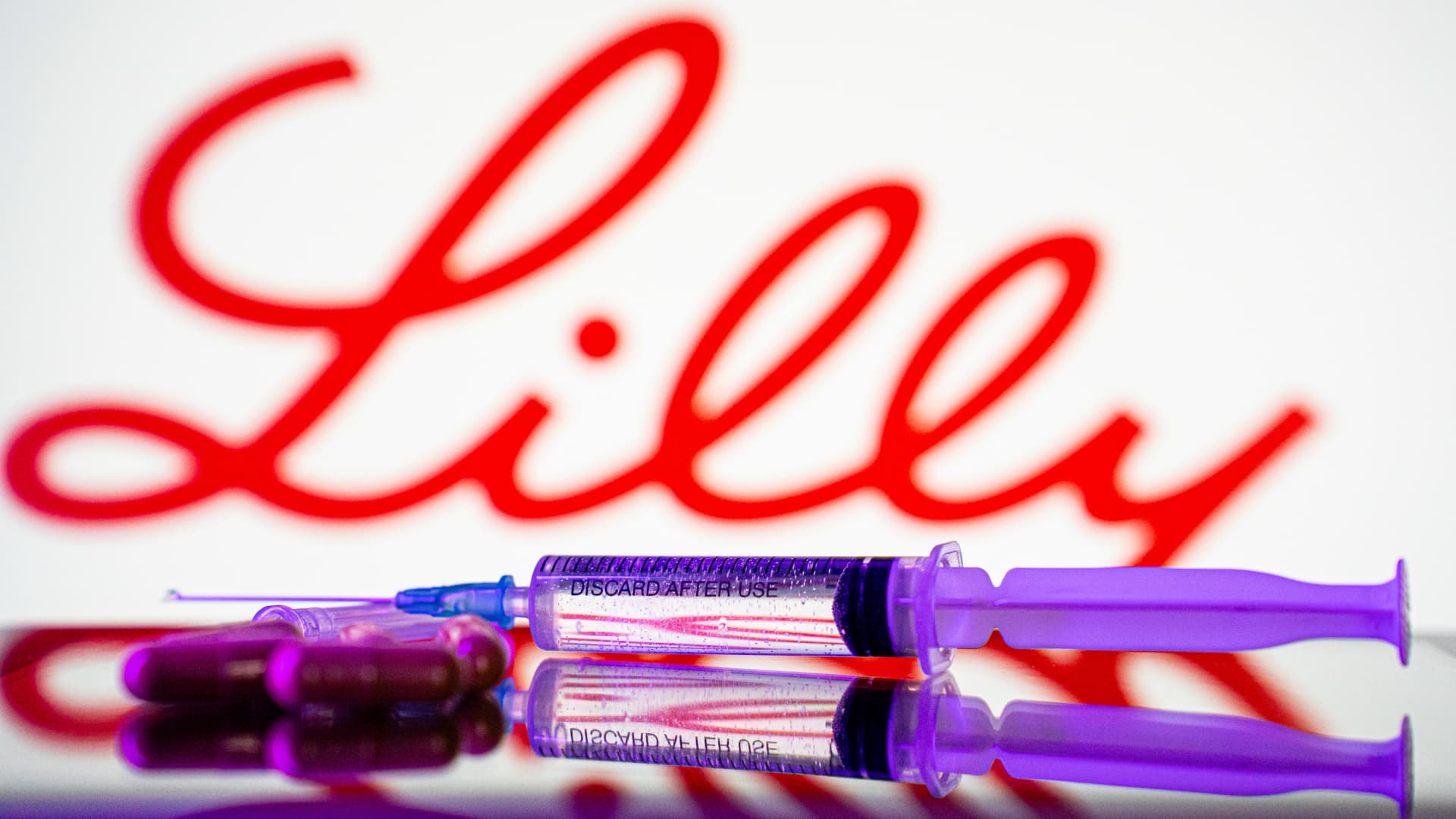Eli Lilly Biotechnology Center is shown in San Diego, California, USA, on March 1, 2023.
Mike Blake | Reuters
Eli Lilly On Tuesday, its daily weight loss pill helped patients with obesity and type 2 diabetes to throw weight in a late stage trial, fulfill the main objective of the study and to clear the way for the company to request the approval of the medication worldwide.
The treatment is close to becoming a new needle without a highly lucrative needle for weight loss and diabetes drugs called LPG-1. The most convenient pills could increase the supply for treatments and make them easier to access than the expensive weekly injections that currently dominate the space. The Eli Lilly pill would not come with dietary restrictions, in contrast to a similar oral treatment of the main rival Novo Nordisk.
Eli Lilly's shares rose about 3% on Tuesday.
The highest dose of the pill, orforglipron, helped patients lose 10.5% of their weight, or 22.9 pounds, on average at 72 weeks, compared to the weight loss of 2.2% among which they took a placebo. The weight loss of the drug in the study was 9.6% when analyzing all patients, regardless of interruptions.
Eli Lilly's pill met the other objectives of the trial of helping patients lower their A1C hemoglobin, a measure of blood sugar levels. At the end of the study, most patients no longer fulfilled the criteria for type 2 diabetes depending on that metric. The rate of side effects and treatment interruptions in the study, called Attain-2, seemed to be generally consistent with two recent phase three tests in Eli Lilly's drug.
Eli Lilly said that it now has the complete package of clinical trial data required to request the approval of the medicine for chronic weight control with global regulators. The pharmaceutical giant hopes to launch the pill worldwide “this time next year,” said CEO David Ricks to CNBC in early August.
In an interview, Eli Lilly's scientific director, Daniel Skovronsky, said the pill had “unprecedented efficiency” in patients with obesity and type 2 diabetes, which generally have a more difficult time to lose weight compared to those without diabetes. Skovronsky said that he hopes that patients with diabetes can use the pill before in their illness to stop their progression.
The existing LPG-1 injections have shown a greater weight loss than the Eli Lilly pill, but having an oral option that offers more than 10% for patients with obesity and type 2 diabetes is “really very good, so it is positive,” said Dr. Caroline Apovian, co-director of the Center for Weight Management and Welfare in Brigham and the Women's Hospital.
But he called it “worrying” that more patients, 10.6% of those in the highest dose, stopped taking the pill due to side effects compared to what has been seen in separate studies on existing injections, Eli Lilly and Novo NordiskIt's Wegovy. Apovian said that patients and their prescribers will have to weigh the risks and benefits of the pill and injections by deciding what to take, including convenience, side effects and efficiency.
The side effects of Eli Lilly's pill were mainly gastrointestinal, such as nausea and vomiting, and were mild to moderate in gravity. It is estimated that 23.1% of those who took the highest dose experienced vomiting, while 36.4% and 27.4% had nausea and diarrhea, respectively.
About 20% of patients stopped taking the pill for any reason, which is approximately the same rate as the placebo group. Skovronsky said it reflects a combination of reasons apart from side effects. Those may include patients who wanted to stop participating in an essay because they could access another obesity medication, or those who did not lose enough weight because they were taking a lower dose of the medication.
But he said that most patients remain in the drug and said that “the most important thing here is the scale of the opportunity,” referring to the number of people around the world could benefit from orforgripron. More than 100 million adults only in the United States have obesity, according to centers for disease control and prevention data.
Apovian said that it is more excited about an oral option that enters the market, not because of the amount of weight loss it can promote, but rather its potential to expand access to obesity treatments, especially since a pill is much easier to manufacture than an injection. Apovian expects Eli Lilly pill to have a lower price than the injections, which cost approximately $ 1,000 per month before insurance, and receive a broader insurance coverage.
The results of Tuesday are the third set of late data that the company has published in Orforglipron this year. In April, the pill was successful in a three -shorter phase trial in patients with diabetes without obesity.
Earlier this month, the medicine also reached the objectives of a separate study on patients with obesity and non -diabetes, but did not reach the expectations of Wall Street. The weight loss of the pill was greater in that trial compared to the data on Tuesday, but “that is expected”, given the differences in patient populations, said Dr. Jaime Almondoz, medical director of the weight welfare program at the Southwestern medical center of UT.
In general, some doctors have promoted the weight loss of the pill in the trials, and some analysts say that it will continue to be a viable competitor in space due to factors such as their easier manufacture and lack of dietary restrictions.
“The convenience and specifically the lack of fasting requirements and water restrictions with orforglipron is probably one of the main differentiators when people think of other oral agents with a similar effectiveness for weight change and A1C levels,” said Almondoz.
He said that a pill creates additional opportunities for the individualized care of the patient “where there is more autonomy.” For example, some people may hesitate to take injections to lose weight.
Detailed test data
The essay followed more than 1,600 people, who were randomized to receive three different target doses of the Eli Lilly or a placebo pill. Patients began a lower dose of the drug and gradually increased to four -week intervals to reach their final dose.
More than 50% of patients with the highest dose of Eli Lilly treatment lost at least 10% of their weight in the trial, while 28.4% of those participants lost at least 15%. In the different groups, the company did not reveal how many patients lost at least 5% of their weight.
Orforglipron “may not be the answer” for morbid overweight patients, said Howard Weintraub, clinical director of the Center for Cardiovascular Diseases in Nyu Langone Heart. But he said: “For many people who need to lose a good amount of weight, losing 10% can make a big difference.”
Orforglipron reduced A1C at an average of 1.3% to 1.8% in different doses at 72 weeks, from an initial level of 8.1%. Around 75% of the participants who took the highest dose achieved an A1C of 6.5% or less, which is in or below what the American Diabetes Association defines as diabetes.
Eli Lilly's pill also improved key cardiovascular risk factors.
“Now we have a study after the study with GLP-1 agonists that show that they reduce the very important results, which is what I do every day as a preventive cardiologist,” said Weintraub. “I do my best to avoid having a heart attack, a stroke and death.”
Eli Lilly's pill works similarly to Wagovy's diabetes pill, Ozempic and Novo Nordisk, which goes to an intestinal hormone called LPG-1 to suppress a person's appetite and regulate blood sugar. Novo Nordisk is also looking for the approval of an oral version of Wegovy, which could reach the end of the year.
But unlike those three medications, Eli Lilly's pill is not a peptide medication. That means that the body absorbs more easily and does not require dietary restrictions such as Rybelsus or Oral Wogovy.












